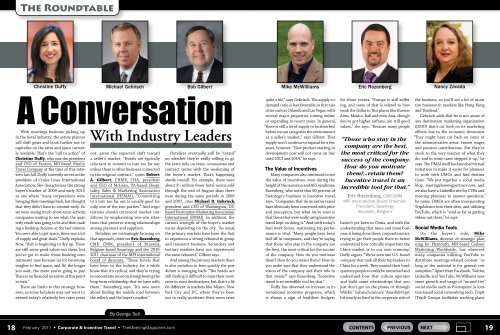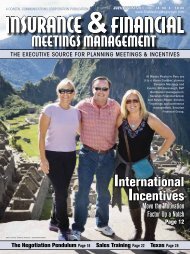Corporate & Incentive Travel - TheMeetingMagazines.com
Corporate & Incentive Travel - TheMeetingMagazines.com
Corporate & Incentive Travel - TheMeetingMagazines.com
Create successful ePaper yourself
Turn your PDF publications into a flip-book with our unique Google optimized e-Paper software.
The Roundtable<br />
Christine Duffy Michael Gehrisch Bob Gilbert Mike McWilliams Eric Rozenberg Nancy Zavada<br />
A Conversation<br />
With meetings business picking up<br />
in the hotel industry, the astute planner<br />
will shift gears and book further out to<br />
capitalize on the rates and space currently<br />
available. That’s the “call to action” of<br />
Christine Duffy, who was the president<br />
and CEO of Fenton, MO-based Maritz<br />
<strong>Travel</strong> Company at the time of this interview<br />
last fall. Duffy currently serves as the<br />
president of Cruise Lines International<br />
Association. She characterizes the strong<br />
buyer’s market of 2009 and early 2010<br />
as one where “many corporations were<br />
bringing their meetings back, but thought<br />
that they didn’t have to <strong>com</strong>mit early. So<br />
we were seeing much short-term activity,<br />
<strong>com</strong>panies waiting to see what the quarterly<br />
result was going to be and then making<br />
a booking decision at the last minute.<br />
You were able to get space; there was a lot<br />
of supply and great deals,” Duffy explains.<br />
Now, “that is beginning to dry up. There<br />
are still some good values out there, but<br />
you’ve got to make those booking <strong>com</strong>mitments<br />
now because (a) it’s be<strong>com</strong>ing<br />
tougher to find space, and (b) the longer<br />
you wait, the more you’re going to pay.<br />
There is no financial incentive at this point<br />
to wait.”<br />
There are limits to this strategy, however,<br />
as some hoteliers may not want to<br />
extend today’s relatively low rates years<br />
With Industry Leaders<br />
out, given the expected shift toward<br />
a seller’s market. “Hotels are typically<br />
reluctant to <strong>com</strong>mit to rate too far out<br />
unless there is other business connected<br />
to the original contract,” notes Robert<br />
A. Gilbert, CHME, CHA, president<br />
and CEO of McLean, VA-based Hospitality<br />
Sales & Marketing Association<br />
International (HSMAI). “Committing<br />
to a rate too far out is usually good for<br />
only one of the two parties.” And negotiations<br />
should transcend market conditions<br />
by emphasizing win-win situations<br />
that preserve strong relationships<br />
among planners and suppliers.<br />
Hoteliers are increasingly focusing on<br />
that approach, observes Eric Rozenberg,<br />
CMP, CMM, president of Brussels,<br />
Belgium-based Swantegy and the 2010-<br />
2011 chairman of the MPI international<br />
board of directors. “Those hotels that<br />
have been in the industry for a while<br />
know that it’s cyclical, and they’re trying<br />
to concentrate more on strengthening the<br />
long-term relationship that we have with<br />
them,” Rozenberg says. “It’s now more<br />
about finding the middle road between<br />
the seller’s and the buyer’s market.”<br />
By George Seli<br />
Hoteliers eventually will be “tested”<br />
on whether they’re really willing to go<br />
the extra mile on rates, concessions and<br />
contract terms with the weakening of<br />
the buyer’s market. That’s happening<br />
slowly overall. For example, there were<br />
about 3½ million fewer hotel rooms sold<br />
through the end of August than there<br />
were during the same periods in 2008<br />
and 2007, cites Michael D. Gehrisch,<br />
president and CEO of Washington, DCbased<br />
Destination Marketing Association<br />
International (DMAI). In addition, the<br />
current strength of the buyer’s market<br />
varies depending on the city. “As usual,<br />
the primary markets have been the first<br />
to experience a strong rebound in group<br />
and transient business. Secondary and<br />
tertiary markets have not experienced<br />
the same rebound,” Gilbert says.<br />
And among the primary markets there<br />
is also variation in how quickly the pendulum<br />
is swinging back. “The hotels are<br />
still finding it difficult to raise their room<br />
rates in most destinations, but that’s a little<br />
different in markets like Miami, New<br />
York City and DC, where they’ve been<br />
out to really accelerate their room rates<br />
quite a bit,” says Gehrisch. The supply-todemand<br />
ratio is less favorable in first-tier<br />
cities such as Orlando and Las Vegas, with<br />
several major properties <strong>com</strong>ing online<br />
or expanding in recent years. In general,<br />
“there is still a lot of supply to be absorbed<br />
before we can categorize the environment<br />
as a seller’s market,” says Gilbert. That<br />
supply won’t continue to expand for a few<br />
years, however. “New product starting in<br />
development now will not <strong>com</strong>e on line<br />
until 2013 and 2014,” he says.<br />
The Value of <strong>Incentive</strong>s<br />
Many <strong>com</strong>panies also continued to see<br />
the value of incentives, even during the<br />
height of the recession and AIG syndrome.<br />
Rozenberg, who notes that 80 percent of<br />
Swantegy’s business is incentive travel,<br />
says, “Companies that do incentive travel<br />
have obviously been concerned with price<br />
and perception, but what we’ve seen is<br />
that those that were really using incentive<br />
travel kept on doing it.” And with today’s<br />
lean work forces, motivating top performance<br />
is vital. “Many people have been<br />
laid off in <strong>com</strong>panies, and they’re saying<br />
that those who stay in the <strong>com</strong>pany are<br />
the best, the most critical for the success<br />
of the <strong>com</strong>pany. How do you motivate<br />
them? How do you retain them? How do<br />
you make sure that they understand the<br />
vision of the <strong>com</strong>pany and their role in<br />
that vision?” says Rozenberg. “<strong>Incentive</strong><br />
travel is an incredible tool for that.”<br />
Duffy has observed an increase in international<br />
incentive programs, which<br />
is always a sign of healthier budgets<br />
for those events. “Europe is still suffering,<br />
and some of that is related to how<br />
weak the dollar is. But places like Buenos<br />
Aires, Mexico, Bali and even Asia, though<br />
you’ve got higher airfares, are still good<br />
values,” she says. “Because many people<br />
“Those who stay in the<br />
<strong>com</strong>pany are the best,<br />
the most critical for the<br />
success of the <strong>com</strong>pany.<br />
How do you motivate<br />
them?...retain them?<br />
<strong>Incentive</strong> travel is an<br />
incredible tool for that.”<br />
Eric Rozenberg, CMP, CMM<br />
MPI International Board Chairman<br />
President, Swantegy<br />
Brussels, Belgium<br />
haven’t yet been to China, and with the<br />
understanding that more and more business<br />
is being done there, corporations are<br />
trying to get their people there to better<br />
understand how critically important the<br />
China market is to our own economy,”<br />
Duffy argues. “We’ve seen one U.S.-based<br />
<strong>com</strong>pany that took all their top leaders to<br />
China for a week. They wanted their headquarters<br />
people to really be immersed and<br />
understand how that culture operates<br />
and build some relationships that you<br />
just don’t get on the phone or through<br />
WebEx.” Gehrisch concurs: “Asia didn’t get<br />
hit nearly as hard in the corporate side of<br />
the business, so you’ll see a lot of incentive<br />
business in markets like Hong Kong<br />
and Thailand.”<br />
Gehrisch adds that he is not aware of<br />
any destination marketing organization<br />
(DMO) that’s cut back on its marketing<br />
efforts due to the economic downturn.<br />
“They might have cut back on some of<br />
the administrative areas, frozen wages<br />
and pension contributions. But they’ve<br />
stuck to the very essence of what they<br />
do, and in some cases stepped it up,” he<br />
says. The DMAI itself has launched virtual<br />
initiatives to make it easier for planners<br />
to work with DMOs and find destinations.<br />
“We put together a social media<br />
blog, meetingplanningpartners.<strong>com</strong>, and<br />
we also have a LinkedIn site for CVBs and<br />
meeting planners to answer questions,”<br />
he notes. DMOs are often incorporating<br />
TripAdvisor into their sites, and utilizing<br />
YouTube, which is “viral as far as getting<br />
videos out there,” he says.<br />
Social Media Tools<br />
On the buyer’s side, Mike<br />
McWilliams, director of strategic planning<br />
for Plymouth, MN-based Carlson<br />
Marketing Worldwide, has observed<br />
many <strong>com</strong>panies utilizing YouTube to<br />
distribute meetings-related content “as<br />
long as the material is for general consumption.”<br />
Apart from Facebook, Twitter,<br />
LinkedIn and YouTube, McWilliams sees<br />
some growth and usage of “second tier”<br />
social media such as Foursquare (a location-based<br />
social networking tool), TripIt<br />
(TripIt Groups facilitates tracking plane<br />
18 February 2011 • <strong>Corporate</strong> & <strong>Incentive</strong> <strong>Travel</strong> • <strong>TheMeetingMagazines</strong>.<strong>com</strong><br />
19



